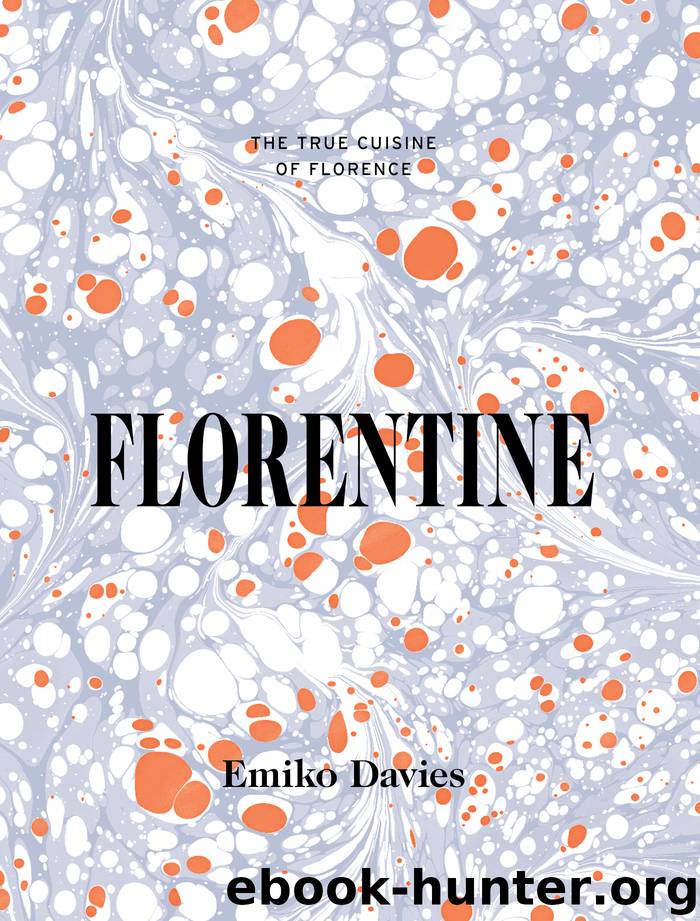Florentine by Emiko Davies

Author:Emiko Davies
Language: eng
Format: epub, azw3
Tags: ebook
Publisher: Hardie Grant
Published: 2015-02-21T16:00:00+00:00
Ribollita
VEGETABLE & BEAN SOUP
The classic Florentine winter soup, ribollita, literally means ‘reboiled’, which not only implies the use of leftovers but also refers to one of the essential techniques in getting this soup just right. Using stale bread, seasonal vegetables and reliable beans, this is a cheap and nourishing dish.
A key ingredient for this recipe is cavolo nero (Tuscan black kale), a durable, dark green, almost bluish cabbage with long, slender bumpy leaves. At a certain point in winter, cavolo nero seems to be the only thing that you can find in the markets. Florentines use it in many winter dishes: in soups, as a topping for crostini or as a side dish to serve with meat.
Also key is the stale bread, it is what lends the soup its characteristic thickness. Ribollita, along with pappa al pomodoro and panzanella, is one of the favourite ways to use up stale Tuscan bread – indeed, it’s a reason to buy the bread fresh and let it go stale. If you don’t have proper, unsalted Tuscan bread handy, use a good Italian loaf, preferably springy and white, with a dark, hard crust.
Artusi’s recipe for ribollita is, more than one hundred years later, still one of the best ways to make it and every Tuscan household probably does some slight variation on this. This is mine. The way my in-laws (like many Tuscans) like to serve this is with a quarter of a fresh red onion – dip it into the soup and take crunchy bites of onion and soup together. It’s not for the faint hearted or those who don’t like onion breath but it is certainly an authentic way to eat ribollita.
250 g (9 oz) drained, cooked cannellini (lima) beans, either homemade (Fagioli all’ Olio) or tinned
1 small brown onion, finely chopped
1 garlic clove, finely chopped,
½ celery stalk, finely chopped
5–6 flat-leaf parsley stalks, finely chopped
30 g (1 oz) pancetta, finely chopped
2 tablespoons extra-virgin olive oil
1 tablespoon tomato paste (concentrated purée)
125 g (4½ oz) savoy cabbage (about ¼ head), chopped
125 g (4½ oz) silverbeet (Swiss chard), central veins removed and leaves chopped
125 g (4½ oz) cavolo nero (Tuscan black kale), central veins removed and leaves chopped
1 potato, peeled and diced
125 g (4½ oz) stale bread, cut into chunky pieces, crusts removed
1 red onion, quartered (optional)
Purée about half of the beans together with about 125 ml (4 fl oz/½ cup) of the bean cooking liquid (or water if using tinned beans) until smooth. Set aside.
Place the onion, garlic, celery, parsley stalks and pancetta in a large stockpot and cook in the olive oil over a low heat. Gently sweat the onion until translucent, about 10 minutes. Add the tomato paste and cook, stirring, for about 2 minutes. Add the cabbage, silverbeet, cavolo nero and potato and cover with 1 litre (34 fl oz/4 cups) water. Season with salt and pepper, then add both the puréed and whole beans. Bring to a simmer, uncovered, and cook until the vegetables are cooked and tender, about 30 minutes – test for tenderness with the poke of a fork.
Download
This site does not store any files on its server. We only index and link to content provided by other sites. Please contact the content providers to delete copyright contents if any and email us, we'll remove relevant links or contents immediately.
Biscuits: A Savor the South Cookbook by Belinda Ellis(4290)
The French Women Don't Get Fat Cookbook by Mireille Guiliano(3604)
A Jewish Baker's Pastry Secrets: Recipes from a New York Baking Legend for Strudel, Stollen, Danishes, Puff Pastry, and More by George Greenstein(3545)
Better Homes and Gardens New Cookbook by Better Homes & Gardens(3525)
Ottolenghi Simple by Yotam Ottolenghi(3515)
Al Roker's Hassle-Free Holiday Cookbook by Al Roker(3499)
Trullo by Tim Siadatan(3379)
Bake with Anna Olson by Anna Olson(3356)
Hot Thai Kitchen by Pailin Chongchitnant(3320)
Panini by Carlo Middione(3252)
Nigella Bites (Nigella Collection) by Nigella Lawson(3172)
Momofuku by David Chang(3140)
Salt, Fat, Acid, Heat: Mastering the Elements of Good Cooking by Nosrat Samin(3108)
Modern French Pastry: Innovative Techniques, Tools and Design by Cheryl Wakerhauser(3076)
Best of Jane Grigson by Jane Grigson(2946)
Classic by Mary Berry(2942)
Solo Food by Janneke Vreugdenhil(2929)
Tapas Revolution by Omar Allibhoy(2927)
Ottolenghi - The Cookbook by Yotam Ottolenghi(2871)
